Central Park is one of those places that make New York such a great place to live. The huge park, which encompasses about 341 hectares (843 acres), is located in the center of Manhattan. Its design has served as an example for city parks around the world.

The park boasts several lakes, theaters, ice rinks, fountains, tennis courts, baseball fields, many playgrounds and other facilities. It is also home to Central Park Zoo and the Metropolitan Museum of Art. Especially during the weekends, when cars are not allowed into the park, Central Park is a welcome oasis in this hectic city.
History
Conception
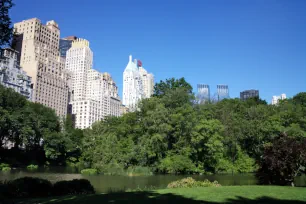
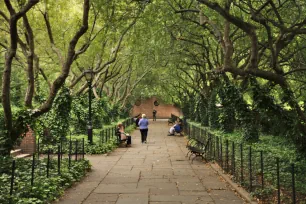
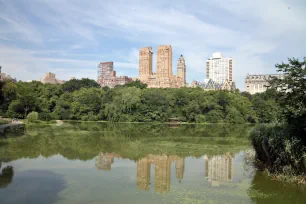
When the terrain for Central Park was bought by the City of New York in 1853, it was far away from civilization, somewhere between the City of New York and the village of Harlem. The area contained sheds from colonists, quarries, pig farms and swamps.
In 1857, the City of New York organized a competition for the design of this new park, which had to rival the great parks in London and Paris. A design by Frederic Law Olmsted and Calvert Vaux, named «the Greensward Plan» was chosen.
This plan featured an English-style landscape with large meadows, several lakes and hills. Winding pedestrian roads were separated from main roads and the huge number of trees ensured the city’s buildings were not visible from within the park.
Creation
To convert the swampy area into the park the designers had envisioned, several hundred thousand trees were planted, more than 3 million cubic yards of soil was moved, roads and bridges were constructed and a large reservoir was dug out. It took more than 15 years before the 20,000 workers had completed the park. Central Park immediately became a popular place for all New Yorkers, attracting millions of visitors each year.
From Relaxation to Recreation
Frederic Law Olmsted’s goal was to create a place where people could relax and meditate. He saw the park as a kind of social experiment where people from both upper and lower classes would meet, a rather revolutionary idea at that time.
After the appointment of Robert Moses in 1934 as New York City Parks Commissioner, the focus of the park shifted from relaxation to recreation. During Moses’s 26-year tenure he constructed many sports facilities, playgrounds and the Wollman rink. He also renovated the zoo, and installed several sculptures including «Alice in Wonderland» ![]() .
.
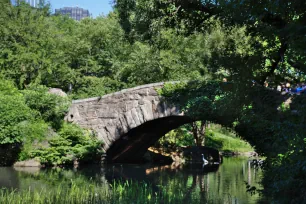
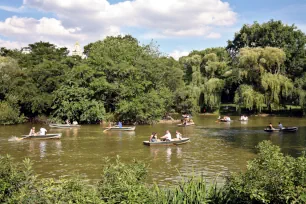
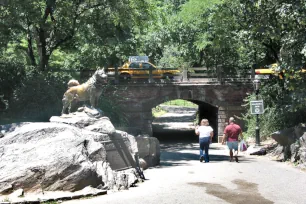
Decline and renovation
After the departure of Moses in 1960, Central Park started to decline. Graffiti, garbage and criminality kept both citizens and tourists from visiting the park. In the 1970s the park became a symbol of New York City’s decline.
The tide started to turn in 1980 when a group of citizens created the Central Park Conservancy. Together with the city, it started a 50-million-dollar renovation project. Several parts of the park, including Sheep Meadow and Bethesda Terrace were restored. Three employees were hired to remove the graffiti – it took them three years to complete this task. Criminality was reduced with the deployment of a large police force.
Thanks to these efforts by both the city and private groups, Central Park is now a relatively clean and safe place, visited by more than 30 million people each year.
Sights & Attractions
There’s plenty to see and do in Central Park. Sports facilities can be found all over the park but most of the interesting sights are found in the lower half of Central Park. You’ll come across historical buildings, statues, monuments, beautiful bridges, and of course plenty of nature. Some of it is quite rugged like the forest-like Ramble while other parts of the park are more manicured and feature beautiful flowers and shrubs.
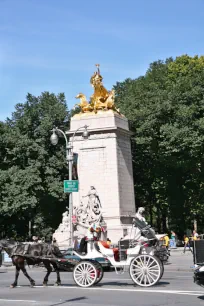


There are eighteen gated entrances to the park. Each of them has its own name. Several of these gates are ornate such as the Vanderbilt Gate, Engineers’ Gate and in particular Merchants’ Gate at Columbus Circle.
Columbus Circle
Columbus Circle is a traffic circle home to two major monuments: at its center stands a statue of Columbus ![]() perched on a tall column. It was installed here on the occasion of the 400th anniversary of the explorer’s arrival on American shores.
perched on a tall column. It was installed here on the occasion of the 400th anniversary of the explorer’s arrival on American shores.
Entering Central Park from the traffic circle through Merchants’ Gate you pass along the impressive Maine Monument ![]() . The monument commemorates the more than 250 sailors who perished in 1898 when the battleship Maine exploded in the harbor of Havana, Cuba.
. The monument commemorates the more than 250 sailors who perished in 1898 when the battleship Maine exploded in the harbor of Havana, Cuba.
Grand Army Plaza
Another popular entrance to Central park is Scholars’ Gate at Grand Army Plaza, near Fifth Avenue. The plaza is a sight on its own. It is divided into two sections by 59th Street.
The southern part features the Pulitzer Fountain ![]() , a beautiful Beaux-Arts fountain that was built with funds bequeathed by Joseph Pulitzer, a newspaper publisher of Hungarian descent.
, a beautiful Beaux-Arts fountain that was built with funds bequeathed by Joseph Pulitzer, a newspaper publisher of Hungarian descent.
The north part is centered around a gilded statue of General William Tecumseh Sherman ![]() , a famous Union Army general during the Civil War. The monument was built in 1902 by Saint-Gaudens and shows the general on horseback accompanied by an allegorical statue of Victory.
, a famous Union Army general during the Civil War. The monument was built in 1902 by Saint-Gaudens and shows the general on horseback accompanied by an allegorical statue of Victory.
Near the eastern edge of Grand Army Plaza stands a magnificent ornate lamppost known as the Lombard Lamp ![]() . The lamp was a gift from the city of Hamburg, Germany to New York. It is a replica of the lampposts that line the Lombardsbrücke in Hamburg. The stairs next to the lamp lead to a nice pond with a beautiful stone bridge.
. The lamp was a gift from the city of Hamburg, Germany to New York. It is a replica of the lampposts that line the Lombardsbrücke in Hamburg. The stairs next to the lamp lead to a nice pond with a beautiful stone bridge.
Central Park Zoo
Just north of Grand Army Plaza is one of the park’s most popular attractions: Central Park Zoo. The zoo has exhibits divided into several regions such as a tropic zone and polar circle. Some of its popular residents include polar bears, snow leopards, red pandas and penguins. Just north of the Central Park Zoo is the Tisch Children’s Zoo, where small children can see and touch domestic animals.
On the path connecting the two zoos, demarking the end of Central Park Zoo, stands an archway featuring a large musical clock known as the Delacorte Clock ![]() . The clock – which was unveiled in 1965 – features bronze animals, each one playing a different instrument. During the day they come to life every half hour when the two bronze monkeys at the top strike the large bell. A melody starts to play and the bronze figures then start to rotate.
. The clock – which was unveiled in 1965 – features bronze animals, each one playing a different instrument. During the day they come to life every half hour when the two bronze monkeys at the top strike the large bell. A melody starts to play and the bronze figures then start to rotate.
Dairy
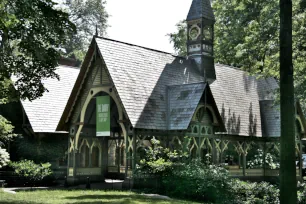
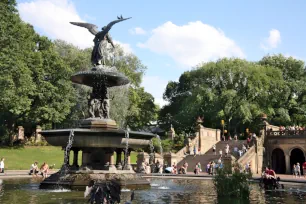
West of the Central Park Zoo is the Dairy ![]() , a Victorian-style cottage from 1870. The picturesque building houses a Visitor Center where you can get maps, guides, gifts, and information on events that are planned in Central Park. The Dairy is located at a former pasture, where cows grazed to provide fresh milk for the city’s children, hence the name of the building.
, a Victorian-style cottage from 1870. The picturesque building houses a Visitor Center where you can get maps, guides, gifts, and information on events that are planned in Central Park. The Dairy is located at a former pasture, where cows grazed to provide fresh milk for the city’s children, hence the name of the building.
Bethesda Terrace
The Mall, a wide promenade lined with American elm trees, brings you from the Dairy to Bethesda Terrace, one of Central Park’s architectural highlights. The two-tiered terrace has a central covered arcade flanked by two staircases that lead to a plaza.
The focal point of the plaza is the Bethesda Fountain ![]() , installed here in 1873. The fountain’s statue, titled «Angel of the Waters», is one of the most beautiful in the park. It was created in 1842 by Emma Stebbins to commemorate the opening of the Croton water system, which for the first time provided New York with clean water. Bethesda Terrace overlooks The Lake and Loeb Boathouse
, installed here in 1873. The fountain’s statue, titled «Angel of the Waters», is one of the most beautiful in the park. It was created in 1842 by Emma Stebbins to commemorate the opening of the Croton water system, which for the first time provided New York with clean water. Bethesda Terrace overlooks The Lake and Loeb Boathouse ![]() , where you can rent rowing boats or even a gondola.
, where you can rent rowing boats or even a gondola.
Statues
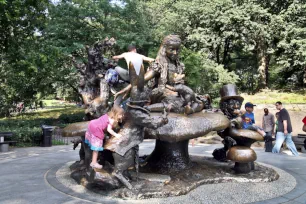
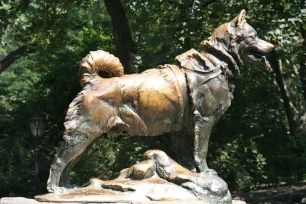
Enthusiasts of remote-controlled model boats head over to Conservatory Water, a pond situated east of The Lake. This is also the site of some of Central Park’s most popular statues.
Just north of the pond is a sculpture group of Alice in Wonderland ![]() , accompanied by her fantastical friends. It is one of the most popular artworks in the park and children love to climb on the giant mushrooms. The sculpture was created by the Spanish-born American sculptor José de Creeft and was unveiled here in 1959.
, accompanied by her fantastical friends. It is one of the most popular artworks in the park and children love to climb on the giant mushrooms. The sculpture was created by the Spanish-born American sculptor José de Creeft and was unveiled here in 1959.
Nearby, on the west side of the pond, stands a statue of Hans Christian Andersen ![]() , the popular Danish author known for his famous fairy tales such as The Ugly Duckling and The Little Mermaid. It is the work of the American sculptor Georg John Lober and was installed here in 1956.
, the popular Danish author known for his famous fairy tales such as The Ugly Duckling and The Little Mermaid. It is the work of the American sculptor Georg John Lober and was installed here in 1956.
Another well-known statue shows Balto ![]() , a Siberian Husky sled dog who in 1925 helped transport medicine across Alaska to deliver a serum necessary to stop a deadly outbreak of diphtheria. The bronze statue was made that same year by the Brooklyn-born sculptor Frederick Roth.
, a Siberian Husky sled dog who in 1925 helped transport medicine across Alaska to deliver a serum necessary to stop a deadly outbreak of diphtheria. The bronze statue was made that same year by the Brooklyn-born sculptor Frederick Roth.
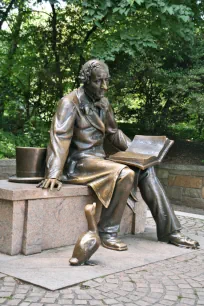
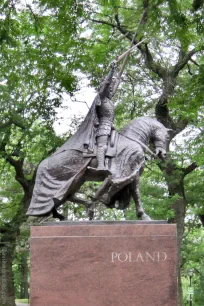
There are several more animal statues in the nearby Central Park Zoo, but the most popular animal sculpture might be the Group of Bears ![]() , three statues of bears that stand on the east side of the park, at the entrance of a playground near 79th Street. The statues were created in 1932 by Paul Manship, and were donated to the park in 1988.
, three statues of bears that stand on the east side of the park, at the entrance of a playground near 79th Street. The statues were created in 1932 by Paul Manship, and were donated to the park in 1988.
Many more statues can be found in Central Park: well over forty statues are spread around the park, mostly in the southern half. A handful of these are clustered around the Mall, a wide tree-covered promenade that leads in a straight line to Bethesda Terrace. The southern section of this promenade is known as «Literary Walk» ![]() due to the many statues of literary figures, including William Shakespeare, Walter Scott, Robert Burns, Fitz-Greene Halleck, and… Christopher Columbus?
due to the many statues of literary figures, including William Shakespeare, Walter Scott, Robert Burns, Fitz-Greene Halleck, and… Christopher Columbus?
Another monument that doesn’t fit the ‘literary’ bill is the «Women’s Rights Pioneers Monument» ![]() . It is a relatively recent addition, and features the first statues of women in Central Park. The work of American sculptress Meredith Bergmann, this monument commemorates the centennial of the ratification of the 19th Amendment, which gave women the right to vote.
. It is a relatively recent addition, and features the first statues of women in Central Park. The work of American sculptress Meredith Bergmann, this monument commemorates the centennial of the ratification of the 19th Amendment, which gave women the right to vote.
There are also some impressive equestrian statues in Central Park. The most famous is the aforementioned statue of General William Tecumseh Sherman ![]() on Grand Army Plaza, but the most impressive one might be that of Władysław II Jagiełło
on Grand Army Plaza, but the most impressive one might be that of Władysław II Jagiełło ![]() , king of Poland and Grand Duke of Lithuania until his death in 1434. The statue commemorates the victory of Jagiełło over the Teutonic Order in 1410. It was created for the 1939 New York World’s Fair by Stanisław Ostrowski and was permanently installed in Central Park in 1945.
, king of Poland and Grand Duke of Lithuania until his death in 1434. The statue commemorates the victory of Jagiełło over the Teutonic Order in 1410. It was created for the 1939 New York World’s Fair by Stanisław Ostrowski and was permanently installed in Central Park in 1945.
At the southern edge of Central Park stand another three equestrian statues alongside one another. They all celebrate Latin America’s independence. The most impressive is that of José de San Martín ![]() , a key figure in the liberation of Latin America from the Spanish Empire. The statue, a gift from the people of Buenos Aires, Argentina, is a replica of the original that was created in 1862 by the French sculptor Louis-Joseph Daumas. José de San Martín is accompanied by Simon Bolívar, another famous leader of the independence movement, and by José Martí, a poet who played an important role in the independence fight of Cuba.
, a key figure in the liberation of Latin America from the Spanish Empire. The statue, a gift from the people of Buenos Aires, Argentina, is a replica of the original that was created in 1862 by the French sculptor Louis-Joseph Daumas. José de San Martín is accompanied by Simon Bolívar, another famous leader of the independence movement, and by José Martí, a poet who played an important role in the independence fight of Cuba.
Sheep Meadow and Great Lawn
Just west of the Mall is one of Central Park’s largest open spaces: Sheep Meadow, an expansive pasture popular in summertime with sunbathers. The Great Lawn, more to the north and at the geographical center of Central Park, is even larger. The oval lawn, created in 1937, often plays host to free summer concerts.
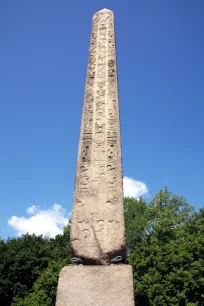
Metropolitan Museum and Cleopatra’s Needle
The most important monument in Central Park is Cleopatra’s Needle ![]() , an authentic Egyptian obelisk, located east of the Great Lawn. The 20-meter-tall granite obelisk was originally erected at Heliopolis and later moved to Alexandria. In the mid-nineteenth century it was donated to the US as a gift from Egypt. The obelisk stands near the Metropolitan Museum of Art
, an authentic Egyptian obelisk, located east of the Great Lawn. The 20-meter-tall granite obelisk was originally erected at Heliopolis and later moved to Alexandria. In the mid-nineteenth century it was donated to the US as a gift from Egypt. The obelisk stands near the Metropolitan Museum of Art ![]() , one of the world’s most important museums, with an enormous collection of artwork from all continents, covering a period from prehistory to today.
, one of the world’s most important museums, with an enormous collection of artwork from all continents, covering a period from prehistory to today.
Strawberry Fields & Shakespeare Garden


There are quite a few themed gardens in Central Park. The most famous of these are probably Shakespeare Garden and Strawberry Fields.
Shakespeare Garden was created in 1913 as the Garden of the Heart. Three years later, on the 300th anniversary of the Shakespeare’s death, it was dedicated to the famous playwright. The garden contains plants that were mentioned in Shakespeare’s plays. Stairs connect the garden with the Swedish Cottage ![]() , a replica of a Swedish school from the nineteenth century. It was transported to Philadelphia on the occasion of the Centennial International Exhibition of 1876 and it eventually ended up here in New York’s Central Park.
, a replica of a Swedish school from the nineteenth century. It was transported to Philadelphia on the occasion of the Centennial International Exhibition of 1876 and it eventually ended up here in New York’s Central Park.
Strawberry Fields is a memorial garden situated near the entrance to Central Park at W 72nd Street. It was created in honor of John Lennon, who was shot dead in front of the nearby Dakota Apartments, where he lived. The tear-shaped garden was dedicated in 1985 as a garden of peace. It is named after a Beatles song written by John Lennon. The famous mosaic with the word Imagine ![]() (another Lennon song) was a gift from the city of Naples in Italy.
(another Lennon song) was a gift from the city of Naples in Italy.
Bridges
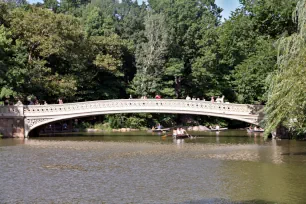
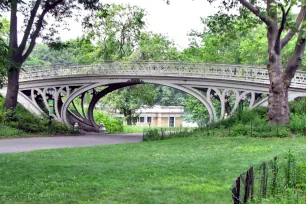
There are many interesting bridges in Central Park. Calvert Vaux – often with the assistance of Jacob Wrey Mould – created almost thirty bridges, each with its own unique design.
The most ornate is Bridge no. 28 ![]() , a cast-iron bridge on the north side of the reservoir, the largest body of water in Central Park. The bridge, which was cast in 1864, is known as the Gothic Bridge, due to its Victorian-era Gothic Revival design.
, a cast-iron bridge on the north side of the reservoir, the largest body of water in Central Park. The bridge, which was cast in 1864, is known as the Gothic Bridge, due to its Victorian-era Gothic Revival design.
In the southwest corner you can find a completely different, but equally picturesque bridge: the Gapstow Bridge ![]() , a small stone bridge that spans a narrow section of the Pond. It was built in 1896 to replace the original cast-iron bridge.
, a small stone bridge that spans a narrow section of the Pond. It was built in 1896 to replace the original cast-iron bridge.
But the most famous bridge in Central Park is undoubtedly the cast-iron Bow Bridge ![]() , which spans The Lake between Cherry Hill near Bethesda Terrace and the Ramble. It was built in 1862 and with a length of 18 meters (60 feet) the longest in Central Park. The graceful bridge is a favorite for wedding photographs.
, which spans The Lake between Cherry Hill near Bethesda Terrace and the Ramble. It was built in 1862 and with a length of 18 meters (60 feet) the longest in Central Park. The graceful bridge is a favorite for wedding photographs.
Ramble and North Woods
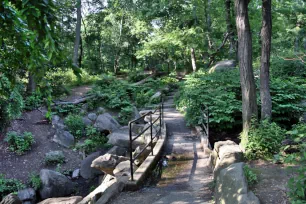
Nature takes center stage at the Ramble, a 15-hectare-large (38-acre) woodland. Here, Central Park is at its most natural, with narrow paths winding through thickets of trees. This is a popular place for bird-watching: the Ramble is on a trans-Atlantic migration route and more than 250 different bird species have been spotted here.
There is another woodland area in Central Park where nature rules: the so-called North Woods, appropriately located in the northernmost part of the park, east of Lake Harlem. This one is even a bit larger and spans an area of over 16 hectares (40 acres). It is also the most rugged part of Central Park due to its dense vegetation, unpaved paths and constant variation in elevation.

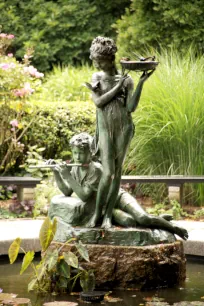
Belvedere Castle
Just north of the Ramble is the Belvedere Castle ![]() , situated at the highest point in the park. The castle was built in 1867-1871 on a large rock as a lookout tower after a design by Calvert Vaux and Jacob Wrey Mould. It was designed as a folly, a fantasy structure that was never meant to be used as a place to live or work in. Nonetheless, in 1919, the U.S. Weather Bureau created offices in the building so that the castle could be used as a weather station.
, situated at the highest point in the park. The castle was built in 1867-1871 on a large rock as a lookout tower after a design by Calvert Vaux and Jacob Wrey Mould. It was designed as a folly, a fantasy structure that was never meant to be used as a place to live or work in. Nonetheless, in 1919, the U.S. Weather Bureau created offices in the building so that the castle could be used as a weather station.
The weather bureau left in 1960, but since 1983 it has been the home of the Henry Luce Nature Observatory, which displays a collection of natural history artifacts including skeletons. You can also peer into telescopes and microscopes. And aspiring natural scientists and naturalists can borrow discovery kits here to go explore the nearby Ramble woodland. The castle overlooks Turtle Pond, named for the many turtles that live here.
Conservatory Garden
The upper part of Central Park is less visited and there are also less interesting sights. One major exception is the Conservatory Garden, the only garden in Central Park with a formal layout. It is divided into three sections: a central Italianate garden flanked by a French-style garden to the north and an English-style garden to the south.
The gardens are adorned with several beautiful fountains, including the Untermeyer Fountain ![]() – which features «Three Dancing Maidens», a sculpture created in 1910 by the German sculptor Walter Schott – and the Burnett Fountain
– which features «Three Dancing Maidens», a sculpture created in 1910 by the German sculptor Walter Schott – and the Burnett Fountain ![]() , a beautiful fountain which was created in memory of Frances Hodgson Burnett, an author best known for her children’s books. Burnett Fountain was created in 1936 by the American sculptor Bessie Potter Vonnoh and depicts Mary and Dickon, two protagonists from «The Secret Garden», one of Burnett’s most popular novels.
, a beautiful fountain which was created in memory of Frances Hodgson Burnett, an author best known for her children’s books. Burnett Fountain was created in 1936 by the American sculptor Bessie Potter Vonnoh and depicts Mary and Dickon, two protagonists from «The Secret Garden», one of Burnett’s most popular novels.
Charles A. Dana Discovery Center

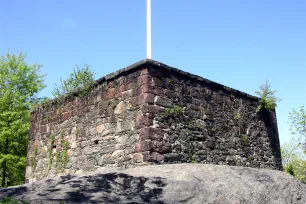
Further up north, bordering Harlem, is Harlem Meer, one of the largest lakes in Central Park. The pretty Victorian-style building near the lake is much younger than it looks: it was built in 1993. It is home to the Charles A. Dana Discovery Center ![]() , an environmental educational center targeting families and children.
, an environmental educational center targeting families and children.
Historical sites
Central Park also features some historical sites that predate the creation of the park. The oldest building in the park is Blockhouse no. 1 ![]() , perched on an enormous rock at the north end of the park in the area known as North Woods. It was built in 1814 during the War of 1812 (1812-1815) as a sort of lookout tower. There were three other blockhouses further to the north, but this is the only surviving one.
, perched on an enormous rock at the north end of the park in the area known as North Woods. It was built in 1814 during the War of 1812 (1812-1815) as a sort of lookout tower. There were three other blockhouses further to the north, but this is the only surviving one.
These blockhouses were built as part of a series of defensive structures built around New York to defend the city against the British. There are several other structures from that period, including Fort Clinton, Fort Fish and Nutter’s Battery that formed a defensive line around the city. None of these were ever used during the war and fell into ruin, but Olmsted and Veaux decided to integrate them into Central Park as interesting historical artifacts.
All three fortifications are situated south of Harlem Meer. Not much is left of these fortifications, but you can spot two cannons (one of them a mortar) at Fort Clinton ![]() , situated just south of Harlem Meer. The cannons are not the original ones that once stood here. They date back to the Revolutionary War (1775-1783) and were recovered from a sunken British warship and donated to the park in 1865. In 2013 it was discovered that the cannon was loaded, but the cannonball and gunpowder have since been removed. The only remnant of Nutter’s Battery is a circular stone wall which indicates where the battery once stood. Its location on a large rocky outcrop makes it a scenic overlook. The same once could be said of Fort Fish, but its views are now obscured by foliage. During the War of 1812, this was the largest of the three fortifications. Today it is an open lawn with a beautiful marble bench that was installed here in 1929.
, situated just south of Harlem Meer. The cannons are not the original ones that once stood here. They date back to the Revolutionary War (1775-1783) and were recovered from a sunken British warship and donated to the park in 1865. In 2013 it was discovered that the cannon was loaded, but the cannonball and gunpowder have since been removed. The only remnant of Nutter’s Battery is a circular stone wall which indicates where the battery once stood. Its location on a large rocky outcrop makes it a scenic overlook. The same once could be said of Fort Fish, but its views are now obscured by foliage. During the War of 1812, this was the largest of the three fortifications. Today it is an open lawn with a beautiful marble bench that was installed here in 1929.
Map of Central Park


